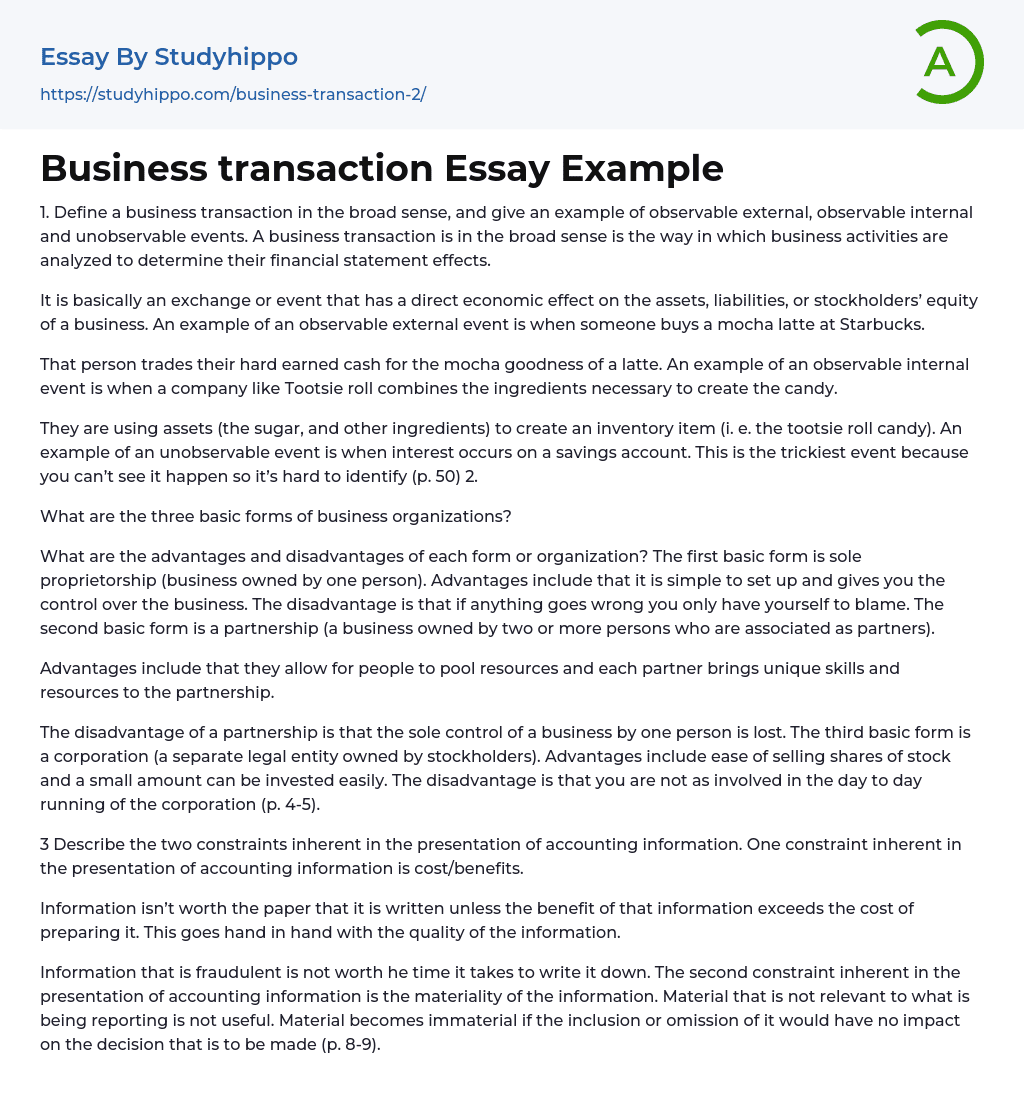1. Define a business transaction in the broad sense, and give an example of observable external, observable internal and unobservable events. A business transaction is in the broad sense is the way in which business activities are analyzed to determine their financial statement effects.
It is basically an exchange or event that has a direct economic effect on the assets, liabilities, or stockholders’ equity of a business. An example of an observable external event is when someone buys a mocha latte at Starbucks.
That person trades their hard earned cash for the mocha goodness of a latte. An example of an observable internal event is when a company like Tootsie roll combines the ingredients necessary to create the candy.
They are using assets (the sugar, and other ingredients) to cre
...ate an inventory item (i. e. the tootsie roll candy). An example of an unobservable event is when interest occurs on a savings account. This is the trickiest event because you can’t see it happen so it’s hard to identify (p. 50) 2.
What are the three basic forms of business organizations?
What are the advantages and disadvantages of each form or organization? The first basic form is sole proprietorship (business owned by one person). Advantages include that it is simple to set up and gives you the control over the business. The disadvantage is that if anything goes wrong you only have yourself to blame. The second basic form is a partnership (a business owned by two or more persons who are associated as partners).
Advantages include that they allow for people to pool resources and each partner brings unique skills
and resources to the partnership.
The disadvantage of a partnership is that the sole control of a business by one person is lost. The third basic form is a corporation (a separate legal entity owned by stockholders). Advantages include ease of selling shares of stock and a small amount can be invested easily. The disadvantage is that you are not as involved in the day to day running of the corporation (p. 4-5).
3 Describe the two constraints inherent in the presentation of accounting information. One constraint inherent in the presentation of accounting information is cost/benefits.
Information isn’t worth the paper that it is written unless the benefit of that information exceeds the cost of preparing it. This goes hand in hand with the quality of the information.
Information that is fraudulent is not worth he time it takes to write it down. The second constraint inherent in the presentation of accounting information is the materiality of the information. Material that is not relevant to what is being reporting is not useful. Material becomes immaterial if the inclusion or omission of it would have no impact on the decision that is to be made (p. 8-9).
- Accounting essays
- Marketing essays
- Automation essays
- Business Cycle essays
- Business Model essays
- Business Operations essays
- Business Software essays
- Corporate Social Responsibility essays
- Infrastructure essays
- Logistics essays
- Manufacturing essays
- Multinational Corporation essays
- Richard Branson essays
- Small Business essays
- Cooperative essays
- Family Business essays
- Human Resource Management essays
- Sales essays
- Market essays
- Online Shopping essays
- Selling essays
- Strategy essays
- Management essays
- Franchising essays
- Quality Assurance essays
- Business Intelligence essays
- Corporation essays
- Stock essays
- Shopping Mall essays
- Harvard Business School essays
- Harvard university essays
- Trade Union essays
- Cooperation essays
- News Media essays
- Waste essays
- Andrew Carnegie essays
- Inventory essays
- Customer Relationship Management essays
- Structure essays
- Starting a Business essays
- Accounts Receivable essays
- Auditor's Report essays
- Balance Sheet essays
- Costs essays
- Financial Audit essays
- International Financial Reporting Standards essays
- Tax essays
- Accountability essays
- Cash essays
- Principal essays




